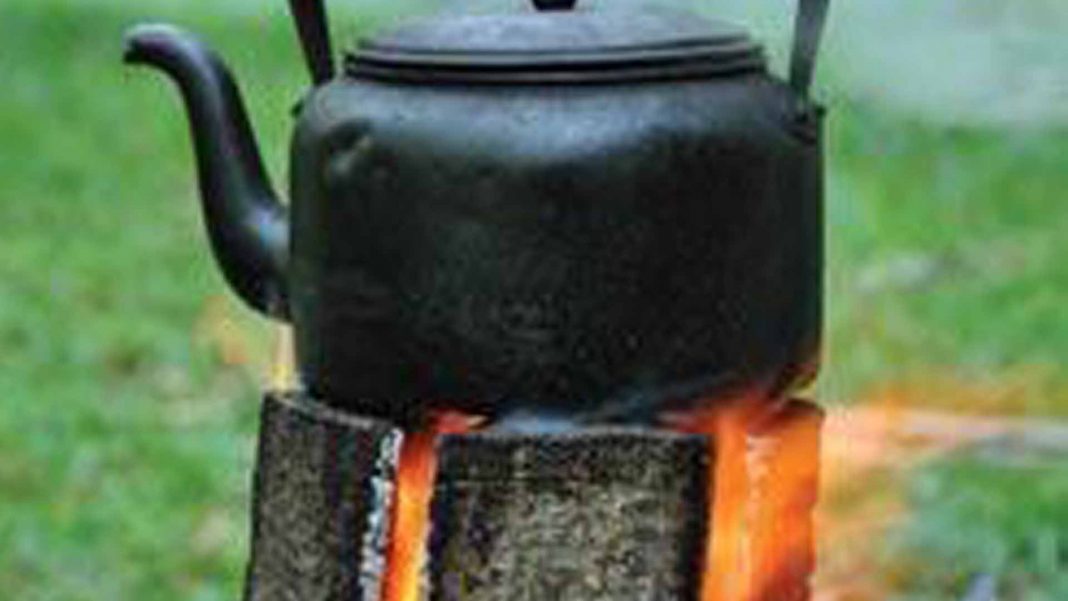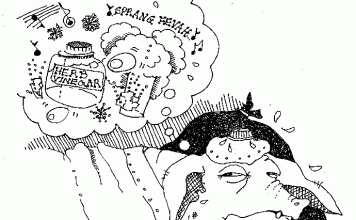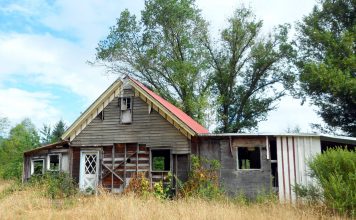| Issue #138 • November/December, 2012 |
At my Hunter-Gatherer school, we are constantly experimenting with different methods of outdoor cookery, from underground ovens (umu or hangi) to smoke roast tipis and run-of-the-mill fire pits. By far the most useful has been the Swedish log candle or Swedish log stove, an ingenious, yet simple natural contraption.
Quite simply, the Swedish log candle is a large upright log with three downward cuts that run almost the entire length of the log. The only things you have to consider are: wood selection, its purpose, and how big you want to make it.

After half an hour of burning, the flat, circular top is ideally suited for a kettle or skillet.
The reason it is so unique lies in its simplicity. It is a self-feeding, one-piece fire unit, perhaps a little impractical for the trail, but excellent for a base camp. The way in which it burns gives rise to four practical uses: to begin with you have an excellent light source. After half an hour of burning (or even before), the flat, circular top is ideally suited for a kettle or skillet. After an hour, the log candle starts churning out a fair bit of heat; then, when you get into the third hour of burning, you are ready to drop down a kebab of your favorite meat for a 360° F slow roasting.
Creating a Swedish long candle couldn’t be simpler: all you need is a good length of seasoned wood, a chainsaw (although you can use a normal saw if you feel your guns are up to it), and some sort of lighter fluid, such as kerosene, to get it going.
Wood selection
Depending on what you intend to use it for will determine the type of wood to choose, but the wood must be well seasoned. For decorative or lighting purposes, a softwood is preferable as it will burn quick and kick out plenty of light. Pine, fir, and birch are perfect choices.
For cooking purposes, stay well away from softwoods as they will taint the meat and cover any pots and pans in soot. Hardwoods such as beech, oak, apple, hornbeam, and cherry are best. We tend to use ash, as it has a lower moisture content (takes less time to season) and burns better than the other hardwoods.
Size
This is completely up to you. You can make small ones to line pathways or for a table centerpiece and you can make huge beasts of log candles as long as the diameter is no bigger than the length of your chainsaw.

When you get into the third hour of burning, you are ready to drop down a kebab of your favorite meat for a 360° slow roasting.
Construction
1. Select your seasoned log. The standard dimensions that we use are 32 inches long by 10 inches in diameter.
2. Ensure that both ends have level surfaces; the thickest end will be the base.
3. Set your log upright on the ground and mark out with a pencil and measuring stick the lines you are going to cut; what you are aiming to create will look like the top of a pie that has been cut into six pieces.
4. Using a chainsaw, make the first cut. The first cut goes straight across the middle of the log. Rip the chainsaw downwards at a steady pace until you get to 5 inches from the bottom; on reaching the 5 inch mark, tip the chainsaw down and inwards to make the cut lower on the outside, this will help draw more air up the log once it is lit, ensuring a better burn.
5. Repeat the cuts on the other marked lines down to the 5-inch mark and remember to tip the chainsaw inwards when you get to the base for airflow.
Lighting
Although you can fill the gaps with tinder, such as strips of birch bark, it is far easier to use a liquid fuel such as kerosene or lighter fluid to get it going. Shy away from gasoline as it is a touch too volatile and should only be used a last resort.
When first lit there will be a small flame shooting out of the top, which will gradually die down and the log will smoke for a short period before the flames start belting out again as the log candle burns from the inside out. In general a log candle of this size will burn for 2-3 hours.
I can thoroughly recommend log candles as the ultimate natural stove. Their versatility is quite astounding and not only are they practical, but they look good too. It’s not often you can light a fire that you don’t have to feed.
To read more from Nick Weston visit www.huntergathercook.com.














